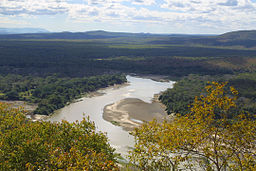Luangwa Valley
| Luangwa | |
| River | |
|
Luangwa River, southern end near Ndevu
|
|
| Country | Zambia |
|---|---|
| Region | Eastern Province |
| Part of | Zambezi |
| Mouth | Zambezi |
| - location | near Luangwa Bridge, Zambia |
|
Luangwa River (red) and part of the Zambezi River (blue)
|
|
The Luangwa River is one of the major tributaries of the Zambezi River, and one of the four biggest rivers of Zambia. The river generally floods in the rainy season (December to March) and then falls considerably in the dry season. It is one of the biggest unaltered rivers in Southern Africa and the 20,000 square miles (around 50,000 square kilometers) that make up the surrounding valley are home to abundant wildlife.
Note: distances stated are approximate straight-line distances from source. The Luangwa rises in the Lilonda and Mafinga Hills in north-east Zambia at an elevation of around 1500 m, near the border with Tanzania and Malawi, and flows in a southwesterly direction through a broad valley. About 150 km from its source it has dropped to an elevation of about 690 m and becomes a meandering river with a flood-plain several kilometres wide. Over the next 300 km the meanders increase, with many oxbow lakes and abandoned meanders. Near Mfuwe, the river's elevation has dropped to about 520 m, the flood plain is about 10 km wide and the valley reaches about 100 km wide, with a north-west escarpment (Muchinga Escarpment) about 700 m high, and a south-western escarpment about 450 m high. In the dry season some sections, especially in the upper reaches, dry out completely, leaving isolated pools.
The upper and middle parts of the valley contain the North Luangwa National Park and South Luangwa National Parks of Zambia, which are among some of the finest in Africa. The river itself is home to large populations of hippopotami and crocodiles. The world's largest concentration of hippos lives in the Luangwa Valley. In the dry season they are restricted by the shrinking river and pools, and are easily seen especially in isolated pools.
In addition to being a source of water, the oxbow lakes and pools increase the biodiversity of the valley in other ways. The hippopotami which live in them feed on land vegetation at night. Their dung feeds some fish and fertilises the pools, increasing fish life which in turn feed crocodiles and birds.
...
Wikipedia


